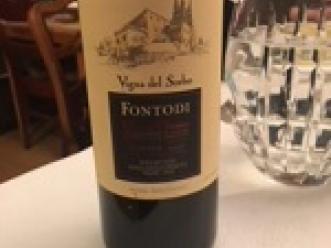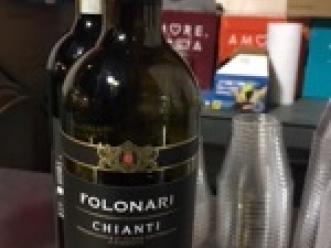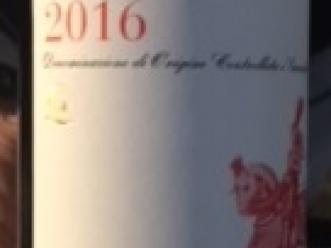The region of Tuscany makes many outstanding and well knows wines. Intowine.com has already explored Super Tuscans, Chianti, Vino Nobile di Montepulciano and Brunello di Montalcino and even the dessert wine Vin Santo. There are other great wines being produced in this Mecca of food and wine. One which does not get as much publicity is called Morellino di Scansano (more-eh-LEEN-oh dee scahn-SAH-no). This red wine is made in the Maremma region around the coastal areas in southern Tuscany and is about a dozen miles inland from the Tyrrhenian Sea.
Morellino di Scansano is a DOCG wine. It was originally granted DOC status back in 1978 and upgraded to DOCG in 2007. Morellino is the local name for the variety of Sangiovese that grows there. Legend has it that the grape was given its name because the brown hue of the grapes is similar the color of the Marmmano horses of the area. Scansano is the name of a village in the region. The wines must be at least 85% Sangiovese with the remaining 15% made up of local red varieties including Mammolo, Canaiolo Nero Alicante, Malvasia, Nera, Nero Francese, Cabernet Sauvignon, Merlot, Ciliegiolo among others although some producers do include 100% Sangiovese. Sangiovese, you will recall, is the grape that is the basis for Chianti, Brunello, Vino Nobile di Montepulciano and many Super Tuscan wines. The wine is a dry wine and can be released in the March after harvest; there is no requirement it be aged in wood. Morellino di Scansano can also be released as a Riserva which requires 24 months of ageing, at least one of these must be in wood.
Wines have been made in this area for a long time; there are records from 1884 attesting to the quality of wines from Scansano. It is only in the last twenty years or so that the world has been paying attention. In the last decade the wines of this area have become an almost trendy alternative to Chianti or some of the other Sangiovese based wines of Tuscany. Personally, I cannot tell the difference between the Morellino strain of Sangiovese and others. Indeed, I wonder if the difference that existed historically is still different as new vineyards have been planted. Add to that the inclusion of the other 15% and it is difficult to say just what a classic Morellino di Scansano should taste like.
The wines offer wonderful cherries and black cherries on the nose. On the palate, the same cherry profile with some leather and with a year or so of age, a bit of earthy damp forest floor. The wines are not especially tannic, and drink well young. These are not wines made for long term ageing, but rather, near term enjoyment over a meal.
More and more of these wines are being exported. For now there are a handful of wineries that are my favorite. One is Fattoria Le Pupile owned by Elisabetta Geppeti. Their best is from a single vineyard and carries the Poggio Valente designation. It is made in both a regular and a Riserva. The basic wines cost around $20 and the top end goes for around $50. A mid-priced wine is made that carries the Elisabetta Gepetti name on the label. These wines include a small percentage of Alicante or Malvasia Nera which soften the wines a bit.
Another top producer has the non-Italian sounding name of Moris Farms (referred to in Italy as Cantine Fattorie Moris). This large producer, owned by Adolfo Parentini and led by consulting enologist, Attilio Pagli, make big and bold internationally styled wine. The regular bottling is 90% Sangiovese, 5% Merlot and 5% Syrah. It sees no time in wood. The Riserva is also 90% Sangiovese and 10% Cabernet Sauvignon and Merlot. It sees a year in wood, 75% in barrique and 25% in large oak casks. The basic wine is about $15 while the Riserva is around $35.
A newer producer is La Mozza who makes a Morellino di Sansano called I Perazzi. This is a project of celebrity chefs Mario Batali, Lydia Bastianich and Joe Bastianich. The wine is a blend of 85% Sangiovese, 4% Syrah, 4% Alicante, 3% Colorino, and 4% Ciliegiolo. It sees 75 % new French oak for ten months. The wine is modern with pronounced cherry and spice flavors. It drinks well on purchase.
A more traditional producer to look for is Poggio Aregntiera. The wine has 5% Alicante, a local version of Grenache, which gives is a softer quality. Their Sangiovese is harvested from older vines that give their wines depth. They make two Morellino’s. The Bellamarsilia is 85% Sangioves, 10% Ciliegiolo, and 5% Alicante. Even better is the Capatosta. It is 95% Sangioves and 5% Alicante. This is a serious wine with firm tannins that need a year or two to unwind. It is concentrated, modern and jammy.
Some other producers to look for include Belguardo, Erik Banti, and Col de Bacche. There are new producers all the time and the wines are often inexpensive enough to allow us consumers to experiment a bit.
These wines should be consumed with food. They go great with pizza or spaghetti and just about any Tuscan fare with a tomato sauce. They also go great with grilled meats.
Tuscany has been on a roll with good and great vintages lately. Almost any vintage from 2004 on should be excellent. Older vintages are more suspect as these wines do not always age well. For your convenience, you may want to peruse the Tuscany, Italy, Vintage Chart.
I hope you all go out and try a bottle. Please let me know what you think.
Loren Sonkin is an IntoWine.com Featured Contributor and the Founder/Winemaker at Sonkin Cellars.





